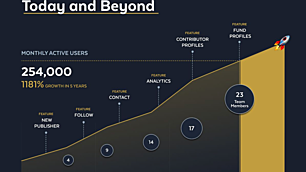A quick explainer on fund ratings
Livewire just released our inaugural list of 100 Top-Rated Funds and we've been delighted with the interest in the series. In compiling the list we drew on the latest rating information from three prominent research houses Lonsec, Morningstar and Zenith.
I thought it would be helpful to provide a short explainer on fund ratings, how they are generated, and what they mean, and how they can help you become a more informed and successful investor.
You can access more background information on the 100 Top-Rated Funds Series in the following article.

Who conducts the fund ratings?
To assist in compiling the list of Livewire’s 100 Top-Rated Funds we drew on the ratings from Lonsec, Morningstar and Zenith. There are other research providers in the market that operate within different niches or specialise in a specific asset class.
Each of the research houses employs a team of analysts that are responsible for conducting reviews of the various managed funds under their coverage. These reviews are usually conducted on an annual cycle.
Who uses fund ratings?
Research and ratings are used primarily by financial advisors for their retail investor clients. However, institutions like super funds also draw on external research.
Many financial advice firms will rely on the ratings to determine which funds make it onto their Approved Product List (APL) for inclusion in client portfolios. For example, an advice firm may decide that the APL will only carry funds with the highest or second-highest rating. So, you can see the value of these ratings for fund managers looking to reach that advisor network.
Levels of fund ratings
Naming conventions vary across the different research houses but they all follow a similar pattern. There are typically five or six levels ranging from highly recommended, or gold through to redeem (i.e. pull your money out).
- Highly-recommended
- Recommended
- Investment Grade
- Screened Out
- Fund Watch
- Redeem
(Source: Lonsec)
It is worth noting that a high rating does not directly translate to high returns. A high rating effectively means that the research provider has the conviction that the fund will achieve the stated objective.
“We’re not there to judge whether 5% is better than 1%. It is about having conviction that the product will do what it says it will do.” Peter Green, Head of Research, Lonsec
It is also an indication of how the researcher has assessed the fund relative to comparable alternatives or peers for the asset class and investment style.
“We categorise all our funds, they go into categories like Aussie Equity, Large Cap or Value, Growth. The more technical assessment is: Will it do better than the category average - which is effectively their peer group - as well as beat the category benchmark. Our methodology focuses us on those two areas and the higher the conviction, the higher the rating should be.”
Aman Ramrakha, Morningstar
I think this is worth noting because a highly-rated fund can still have poor absolute performance.
The obvious example from recent history would be Value managers in equity funds. The Value style has only just started to emerge from a period of underperformance relative to Growth, yet a Value manager could retain a high rating relative to their peer group (i.e. other Value funds).
Fund ratings methodology
The ratings methodologies across the research houses have similarities and a general overview of the process can be found on the various firms' websites. Each research provider will have developed their own IP so the level of granular detail is somewhat limited.
The processes are typically skewed towards evaluating qualitative factors of a fund rather than a pure focus on performance. These are some examples of the qualitative factors taken into consideration:
- Ownership: What is the ownership structure of the firm e.g. is it staff-owned or is there a parent organisation
- Process: What is the investment process and is it repeatable and consistent
- People: Who are the people with a big focus on stability of the investment team
- Governance: How is the fund run / administered

Image: An illustration of Morningstar's fund rating process (Source: Morningstar)
On the quantitative side, performance is taken into account alongside measures of volatility and fees. These factors are looked at in absolute terms and on a relative basis to their peer group and benchmark.
How does a fund get rated and who pays for ratings?
Ratings typically happen each year and funds can request to be included in the ratings process. There are a few models for how research is paid for. Users of research pay a subscription or license fee to access the research and ratings from the various providers.
Both Lonsec and Zenith also operate a subscription + issuer pays model, meaning that the fund manager pays for the rating to be conducted. The case for this model is that it facilitates resourcing of a research team and lowers the cost of the research to the advice industry.
“I think it's important for people to understand the industry economics. That is, the Australian advice market is too small for subscription to research house services to sustain a properly resourced and qualified research business. The economics of a financial planning practice just do not support it. That is, advisers would have to pay a much higher fee for access to research services and this cost would be passed onto the consumer.”
David Wright, Zenith Investment Partners
The "issuer pays" model does create a potential conflict of interest and this is something the research providers are acutely aware of.
“It’s our number one conflict to manage. So, we spend a lot of time and thought on how to manage this.” Peter Green, Lonsec
ASIC’s Regulatory Guide 79, which was issued in 2012, provides detailed and specific direction on steps they felt would improve the quality of investment research including managing conflicts of interest.
It’s not exactly a page-turner but you can access it here if you are looking for more detail.
More detailed information on fund ratings
For those of you seeking more information you can find plenty of information on the research provider websites.
- Lonsec: (VIEW LINK)
- Morningstar: (VIEW LINK)
- Zenith: (VIEW LINK)
.jpg)
.jpg)
Australia's 100 top-rated funds
Livewire's Top-Rated Fund Series gives subscribers exclusive access to data and insights that will help them make more informed decisions. Click here to view the dedicated website, which includes:
- The full list of Australia’s 100 top-rated funds.
- Detailed fund profile pages, with data powered by Morningstar.
- Exclusive interviews with expert researchers from Lonsec, Morningstar and Zenith.
- Videos and articles featuring 16 top-rated fund managers.

